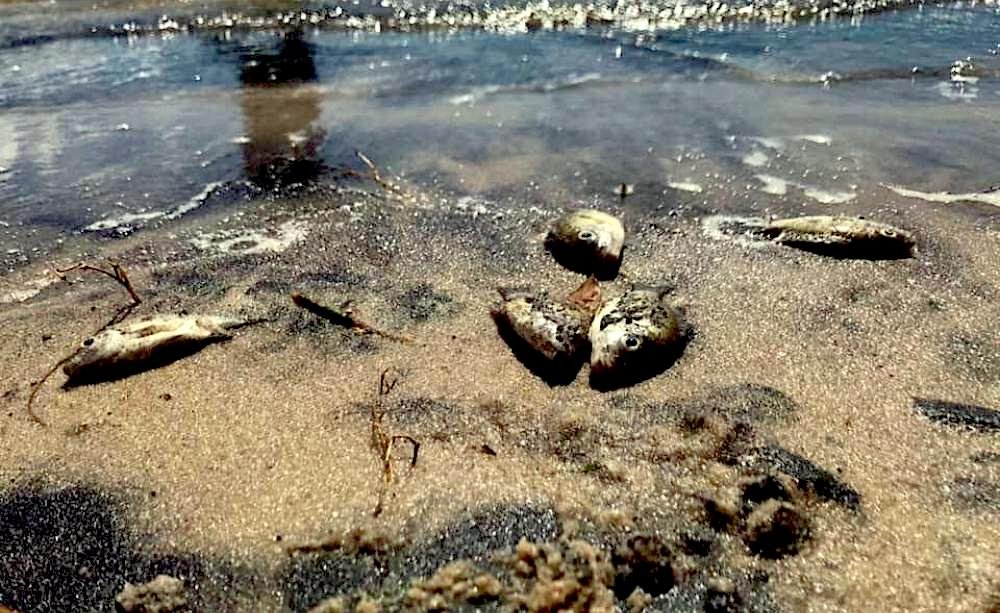- A mine tailings dam in Madagascar has failed at least twice this year, sending hazardous wastewater into a lagoon relied on by locals for drinking and subsistence fishing, killing hundreds of fish.
- Rio Tinto refuses to accept responsibility for the fish or water pollution, and this is not an isolated incident: tailings dams are failing with increasing frequency and severity all over the world.
- “Safety First” is a new set of guidelines toward more responsible tailings storage that prioritizes safety over cost, which companies and investors should heed, a new op-ed argues.
- This post is a commentary. The views expressed are those of the author, not necessarily Mongabay.
Since February of this year, a tailings dam at the QMM mine in Madagascar has failed at least twice. Hazardous mine wastewater overflowed and contaminated the surrounding lagoon system relied on by locals for drinking water and subsistence fishing. Hundreds of fish were found dead.
A subsequent fishing ban has plunged the community into crisis, triggering protests and a roadblock that twice shut down the mine, a joint venture between London-based Rio Tinto and the Malagasy government. Villagers remain encamped along the roadside at the site, waiting for a meaningful solution.
Rio Tinto refuses to accept responsibility for the fish deaths, the water pollution, and even refuses to acknowledge that it operates a tailings dam at the QMM site. It has repeatedly asserted that it has “no mine tailings dam” (AGM 2022) because it claims its waste is impounded by a “berm” or in an “excavated storage facility.” These semantics allow Rio Tinto to avoid compliance with international best practice and dodge accountability for the serious environmental and social impacts of its tailings.
Sadly, this is not an isolated incident. The social, environmental and cultural destruction caused by mine waste storage facilities, called tailings dams, is an enormous liability for the mining industry. However, the industry is not implementing practices to successfully avoid tailings dam failures.
Tailings dams are failing with increasing frequency and severity. A paper published in Scientific Reports in 2021 found that one in 10 tailings facilities reported “notable stability concerns or failure to be confirmed or certified as stable at some point in their history.”
Additionally, the authors point out that only 13 facilities constructed over the last decade of the 1,742 tailings facilities reviewed used a dewatering technology that improves tailings stability. Recent tailings dam failures have led to over 300 deaths, hundreds of kilometers of contaminated rivers and ecosystems, and have cost billions in lost profits and remediation costs for mining companies.
As climate change brings increasingly severe and extreme weather conditions, tailings dams are becoming more and more of a risk. Safer tailings management is more urgent than ever.
In 2020, the Global Tailings Review, a process co-convened by the trade industry association the International Council on Mining and Metals (ICMM), the UN Environment Programme and Principles for Responsible Investment, released its Global Industry Standard on Tailings Management (GISTM). ICMM members have committed to implementing the GISTM at all mines within five years, but their efforts to comply with this standard fall short.
At its 2022 AGM in London, Rio Tinto emphasized its involvement in the GISTM process and the seriousness with which it takes mine tailings management, even as communities in Madagascar suffered as a result of their poor tailings management.
Even if mining companies complied with the GISTM, communities still wouldn’t be safe. While an important first attempt at international tailings dam regulation, the GISTM does not go far enough to establish protective standards that would rein in the most dangerous practices, to ensure affected communities are included in decision making around tailings facilities, and to mandate corporate accountability at the highest levels for tailings dam safety.

It is clear that much more stringent oversight of the mining industry is urgently needed. An international group of scientists, communities and civil society groups (including the author’s NGO, Earthworks) have worked to identify guidelines for more responsible tailings storage that prioritize safety over cost. Recently we published updated recommendations called Safety First: Guidelines for Responsible Mine Tailing Management, based on consultations with over 200 representatives of affected communities, Indigenous people, local environmental and human rights organizations, and technical experts.
Safety First requires companies to ensure that public and environmental safety are the determinative factors governing the operation of tailings facilities, as well as zero tolerance for human harm or fatalities. It recognizes the interconnected relationship between people and the natural environment and says that communities must be afforded the right to say no to tailings facilities they deem too risky.
Investors and regulators need to continue to take bold action to address tailings risks by continuing to improve on the existing standards, and by pushing mining companies beyond their current commitments. The demands of civil society and affected communities provide concrete guidance for what needs to be done. The destruction caused by irresponsible practices in Madagascar shows how mining companies seek to avoid meaningful regulation, and how far is left to go.
Jan Morrill is the Tailings Campaign Manager at Earthworks a non-profit organization working to protect frontline communities from the adverse impacts of mining and energy development while promoting sustainable solutions.
Related audio from Mongabay’s podcast: Who benefits from resource extraction in the DRC? Listen here:
Related reading: The Ambatovy mine in Madagascar achieved no net forest loss by curbing deforestation in its biodiversity offsets, an analysis in the journal Nature Sustainability concluded:
Deforestation-neutral mining? Madagascar study shows it can be done, but it’s complicated














